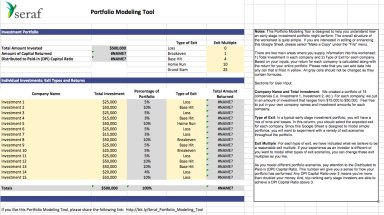
Originally published: 28/11/2017 17:33
Publication number: ELQ-57050-1
View all versions & Certificate
Publication number: ELQ-57050-1
View all versions & Certificate

Excel Financial Model for an Early Stage Investment Portfolio
A comprehensive guide accompanied with explanations and examples to help you create an early stage portfolio
Description
A big challenge early stage investors encounter is the creation of a portfolio of investments that cumulatively returns more than two times of the original amount invested in the portfolio. In other words, the aim is to achieve a Distributed to Paid-In (DPI) ratio greater than two times. For example, for every pound you invest in your portfolio, your aim is to receive two pounds back.
How to use this tool:
A sample portfolio of 15 companies (investments) are on the excel sheet for your to work from. This is plenty to start with for a basic portfolio modelling exercise. For each of these 15 investments there are also two variables that need to be set.
Firstly, you will need to add the amount that you will invest in the companies. Indeed, you may invest the same amount in each of the 15 companies. Or you may even decide to invest different amounts for them. In this template, there is a range of investments.
Secondly, the type of exit will need to be chosen for each of the 15 companies. This is where you determine the capital the companies will return on your portfolio. Considering these are early-stage businesses you are dealing with, you will encounter various returns. It is recommended that you set about half the portfolio to total losses (no capital retuned) if you wish to have a more realistic model.
There is one controllable variable on this template. In the upper right-hand corner there is a section called 'Exit Multiple' for each type of exit. Values for each exit type are already provided but you can modify it using different exit multiples.
Once the two variables for each company are set, you can look at the upper left-hand quadrant of the template. There are three important metrics here.
1. Total Amount Invested: The total of all investment made in the portfolio.
2. Amount of Capital Returned: The total of all the returned capital based on the types of exits for each company.
3. Distributed to Paid-In (DPI) Capital Ratio: This is the multiple of capital your portfolio returns. (A solid DPI is 2 and a top investor will have a DPI of 3 or more).
Something to keep in mind. This investment portfolio template is a useful tool to figure out your overall multiple of returned capital. It however does not take the amount of time it took for the capital to be returned into account. Therefore, watch out for how long this takes. If they take more than ten years to show up, your returns will be less than optimal.
A big challenge early stage investors encounter is the creation of a portfolio of investments that cumulatively returns more than two times of the original amount invested in the portfolio. In other words, the aim is to achieve a Distributed to Paid-In (DPI) ratio greater than two times. For example, for every pound you invest in your portfolio, your aim is to receive two pounds back.
How to use this tool:
A sample portfolio of 15 companies (investments) are on the excel sheet for your to work from. This is plenty to start with for a basic portfolio modelling exercise. For each of these 15 investments there are also two variables that need to be set.
Firstly, you will need to add the amount that you will invest in the companies. Indeed, you may invest the same amount in each of the 15 companies. Or you may even decide to invest different amounts for them. In this template, there is a range of investments.
Secondly, the type of exit will need to be chosen for each of the 15 companies. This is where you determine the capital the companies will return on your portfolio. Considering these are early-stage businesses you are dealing with, you will encounter various returns. It is recommended that you set about half the portfolio to total losses (no capital retuned) if you wish to have a more realistic model.
There is one controllable variable on this template. In the upper right-hand corner there is a section called 'Exit Multiple' for each type of exit. Values for each exit type are already provided but you can modify it using different exit multiples.
Once the two variables for each company are set, you can look at the upper left-hand quadrant of the template. There are three important metrics here.
1. Total Amount Invested: The total of all investment made in the portfolio.
2. Amount of Capital Returned: The total of all the returned capital based on the types of exits for each company.
3. Distributed to Paid-In (DPI) Capital Ratio: This is the multiple of capital your portfolio returns. (A solid DPI is 2 and a top investor will have a DPI of 3 or more).
Something to keep in mind. This investment portfolio template is a useful tool to figure out your overall multiple of returned capital. It however does not take the amount of time it took for the capital to be returned into account. Therefore, watch out for how long this takes. If they take more than ten years to show up, your returns will be less than optimal.
This Best Practice includes
1 Financial Model Template for an Early Stage Investment Portfolio Template

